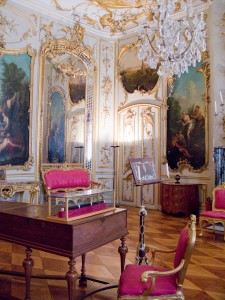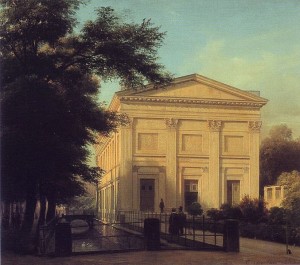The melancholy that pervades French 18th century art springs from an observation that nothing lasts; nothing fine, happy, exquisite, delicious, amorous, luminous, nothing lasts. Leaving Versailles is leaving Eden and leaving Paris is done with regret. Heaven on earth may well be a moment in which our taste buds are being ravished, our eyes delighted, and all our senses satisfied while seated in a restaurant looking inwards to the belle époque décor and outwards to a river of humanity in promenade on a Haussmann boulevard.

My next music project is a program around Frederick the Great and his world at Sans Souci. And so, my partner David and I flew to Berlin, a city neither of us had visited before and both of us longed to know. I wanted to explore the park and palaces in Potsdam and to visit Frederick’s opera house on the great Berlin Avenue, Unter der Linden. Equally important to us are the collections of ancient art on Museum Island, a conglomeration of buildings from the early 19th through the early 20th century built to house collections and individual works of art and archeology. Most personally, I wanted to know the city where Jewish European culture had its greatest moments and its most tragic ones. This was the city where Sarah Itzik (Jewish saloniste and aunt to Felix Mendelssohn) studied harpsichord with Wilhelm Friedemann Bach, and where my stepmother lived in hiding when her father was arrested and taken to the death camps. I needed to spend time here to balance memory and heritage.
When taking your first city walks, it is difficult to come up with a character that describes Berlin. Every main square is a construction site. High cranes define the skyline and loud construction machinery bang and hum grind out the score. From these construction sites large violet or purple pipelines travel long distances over our heads to transfer quantities of underground water to the Spree River or to some large canal. Old facades are patched and repaired, there are acres of apartment block complexes from the communist past and there is the wide scar that runs through the city where the wall used to define boundaries and set limitations. Berlin, like its history, is not an easy city to understand, even to enjoy. But its art treasures are second to none, its 18th and 19th century history of liberal accomplishment and inclusive society is inspiring and starting with the passionate involvement and support of Frederick the Great through the 19th century, its music history is central.

Now here is an interesting historical event that weaves everything together. Our hotel is a short walk to Unter der Linden, very close to the Spree River and the walking route to the Pergamon, Altes and Neues Museums. We pass two great churches framing the most important concert hall of Berlin. Just beyond and on the Boulevard is Frederick the Great’s opera house. This building was burned and bombed so often but always reconstructed (it is under restoration now). It was here that Carl Heinrich Graun produced his presently unappreciated late Baroque operas. Beautiful works. As we walk towards the river, to our left we notice a small, neoclassical building. It is a temple that serves now as a state theater. But looking in our guidebooks we see that this building was the 1827 concert hall built for the Sing-Akademie of Berlin. The Sing-Akademie was an amateur run organization based on the London Academy for Ancient Music. The London “club” was dedicated to the music of Corelli and Handel in the face of the moderns Pleyel and Haydn. It was an organization that looked backwards with respect and nostalgia.
The Berlin institution was founded in 1791 by Carl Fasch. He was a court harpsichordist and student of C. P. E. Bach. Music of living and dead composers made up his programs. Beethoven visited in 1796. By 1800 there were over 100 members. The membership came from the wealthy Berlin Bourgeoisie including many Jews, most important, the Itzig family. Sarah Levy Itzig (1761-1854) studied with Wilhelm Friedemann Bach and collected manuscript of the Bach family, including many of J. S. Bach. Her library, combined with Carl Friedrich Zelter’s and C. P. E. Bach’s widow’s holdings made up the most important Bachiana collection in the world and was the library of the Sing-Akademie. Aunt Sarah urged Felix Mendelssohn to study with Zelter, the director after Fasch, and grow with the influence of Bach’s music. On March 11, 1829, in this small temple-like theater, just to our left as we walked to see the great Pergamon alter, Zelter handed over his baton to young and already famous Felix Mendelssohn to conduct the first performance of the St. Matthew Passion in over 100 years. It was a defining moment in Bach’s central role in Western music as well as one of many moments in which German Jews lead the entire country into a moment of astounding light.
If this building and its history were Berlin’s only call to me, it would be more than sufficient to make me grateful and joyful to be here. Now, on to Sans Souci!




Hi Andrew,
Very nice post. I had the pleasure a few years ago of playing with Dan Stepner, Robert Levin, and Malcolm Bilson in a concert honoring Christoph Wolff at the Academy of Arts and Science in Cambridge, MA. He gave a wonderful talk about Sarah Levy and the Berlin Sing Acadamie; Here it is: http://www.amacad.org/publications/bulletin/spring2005/wolff.pdf
When I visited Potsdam, I was amazed at how small the music room is.
All the best,
Chris
Dear Chris,
Thank you for writing and for giving us all the link to the wonderful article on Sarah!.. Best to you
By the way, I’m sure you know that Zeltner asked Felix to transcribe Handel’s Acis and Galatea before he tried the St. Mathew. That has been discovered and recording a few years ago.
Chris
Dear Andy,
I am joyous to hear of your visit to Berlin. Sy and I know it well and it is always a stop of ours when we’re in Germany. (Sy is there yearly and knows the city like the back of his hand.) Hope you’re able to get to Dresden and environs if you haven’t been there. You won’t want to leave. In fact, Ensemble Musical Offering is producing Hunt Cantata next season — you have to visit some of the hunting lodges while you’re in Germany. We have a list!!
I’ll be keeping up with your trip as I know the foot print very well.
Above my piano in my Perth studio, Western Australia, I have a print copy of the 1852 painting “The Flute Concert” by Adolph von Menzel oil on canvas original in National Gallery Berlin, made in the same music room at Sans Souci. Enjoyed seeing this photo and reading your article. A wonderful city to visit! Berlin has more canals than Venice. Try and hear the Phil in the hall, and the music instrument museum is fascinating.